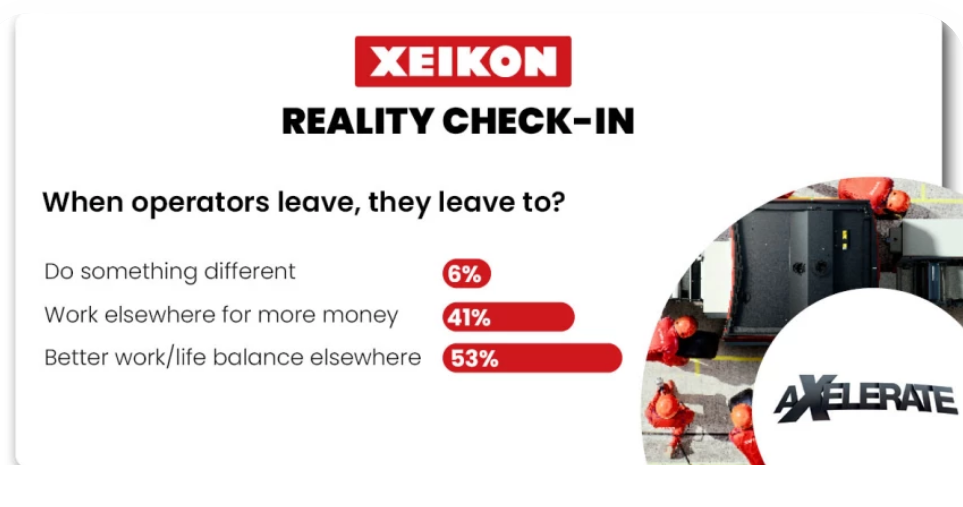By Paul Salmon, Global Customer Success Manager, Xeikon
Read to discover how our Labelexpo talks drove the next aXelerate walks.
It’s a supply-and-demand economy out there and it’s never been more predominant. The scarcity of resources – both human and physical – is challenging the market in 2022 and its consequences will set the scene in 2023. Good preparation takes longer than the delivery, so we put out the feelers at Labelexpo to know what printers are struggling with, so we can help them move forward in 2023.
Open-heart conversations for open-mind discussions at Labelexpo 2022
With all the industry's challenges, it was good to be back at Labelexpo, talking face-to-face with customers and first-time visitors. Online meetings are great, but you learn so much more from the types of deep discussions that can only happen in person.
The topic that came up most frequently was the scarcity of resources. Obviously, printers today are learning how to navigate the shortages of raw materials to the best of their abilities. What seems to be equally poignant, is the lack of skilled labor impacting printers today. As one printer at Labelexpo reported, "Now I have the press and the material, but no operator!" You can look to add more talent to the team, but what if you can’t find them?
Technology may be part of the solution to solving challenges from these shortages. To thrive in these times, printers will need to expand their know-how and services to discover how they can do more with less without disappointing customers, burning margins, or stressing out their remaining crew.
What with the ongoing shortages of raw materials?
Whether talking to Xeikon customers or new prospects, ongoing shortages were still clearly an issue at Labelexpo. Resource scarcity is a reality for everyone, raising many questions on how to navigate these shortages.
Customers report that paper orders are often invoiced at a price on the day of delivery and not on the order date. However, with prices rising between 15 per cent and 60 per cent over the last year, the printer cannot pass on this increase to the customer's accepted quote, so he is forced to cut his margins. How do they minimize this?
1) Stock up. Many printers order large volumes of paper in advance to avoid paper price increases in 2022. This advanced ordering will most likely result in on-demand print deliveries in 2023. If your digital print setup is not up to par, you’re only ending up delaying misery.
2) Other printers investigate redesigning their current production processes. By finding ways to reduce material waste, production time, ink/toner, and electricity consumption while delivering the best quality. This can be a time-consuming process, and not everyone has the resources or time to spend on this.
Are you a 1 or a 2?
If you’re the first type, you may find it reassuring to know that your standard, go-to substrates can also be used on the Xeikon, without any special treatment. They’ll never go to waste. And if you really want to play it safe, our team offers operator trainings sessions, that are solely dedicated to stock management. That way you can gradually reduce your substrate variety, but still produce and deliver everything your brand owner client wants.
If you’re the second type, you might find the Xeikon “Do More with Less” program helpful. The range of actions included in this program can improve all aspects of the print production workflow: reducing lead time, minimizing material waste, and keeping ink/toner consumption and operator efforts to a minimum. The name says what it does, we analyze your data and offering to see how you can do more with less.
What with the challenge of labor in the printing industry?
At Labelexpo, many printers were talking about the challenges they faced from the labor shortage. Their struggle is real and some tales haunting even.
Research done by the Printing Industries Alliance in the US studied these labor shortages in a report titled "Workforce Shortages: Its Effects and Effective Related Practices." Their research found that nearly 70 percent of survey respondents said labor shortages had affected their businesses. Employers indicated that, on average, they could not fill 36 percent of their open positions for more than a year.
Research from the Printing Industries Alliance is ongoing. Still, current thinking is that these shortages are due to various reasons: the printing industry's workforce is shrinking as it ages, there is a lack of (new and) experienced talent, existing talent gets bored of the repetitive work, and workers are choosing to move for more money or move away from jobs in manufacturing altogether.
After Labelexpo, our team launched a LinkedIn poll to check out the results. And they were harrowing indeed:
When operators leave, they leave to
6% -> Do something different
41% -> Work elsewhere for more money
53% -> Better work / life balance elsewhere
In some situations, experienced pressmen don't choose to leap digital processes. But losing a pressman means you lose not only a worker but also all of that worker’s trade knowledge.
So, what do you do?
Pay exuberant wages
Take on less jobs
Train your existing team to diversify their skillset
We believe option C will be the most valuable one if you don’t want to lose more customers, people, or self-respect. To support printers in this time of acute labor shortages, Xeikon created the cloud solution, and the Star Training Program. Like our "Do more with less program," the Star Training Program of aXelerate was designed to give printers vital resources to train and develop their existing staff or the new employee they hire. Our cloud solution will digitalize your operator’s expertise, especially the repetitive jobs. By automating the dull tasks, you’ll reactivate the creative vibes.
Providing training to operators will not only build their skills and confidence, but it will also undoubtedly improve your printing output. Over time, a labor of love always pays off.
www.xeikon.com
